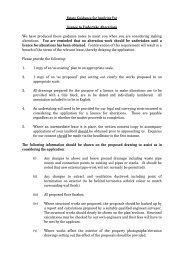The best of Chelsea by the people who know - Cadogan
The best of Chelsea by the people who know - Cadogan
The best of Chelsea by the people who know - Cadogan
Create successful ePaper yourself
Turn your PDF publications into a flip-book with our unique Google optimized e-Paper software.
21 | STREETS & SIGHTS |<br />
<strong>The</strong> station is usually decked with<br />
plants when <strong>the</strong> RHS <strong>Chelsea</strong> Flower<br />
Show (see Events) is running.<br />
Sloane Street<br />
• Jane Austen stayed with her bro<strong>the</strong>r<br />
at 64 Sloane Street (see Hans Town<br />
panel on page 23).<br />
• Statesman and author Sir Charles<br />
Wentworth Dilke (1843-1911) lived at<br />
16 Sloane Street. He had been tipped as<br />
a future prime minister, but a high-pr<strong>of</strong>ile<br />
divorce case in which he was cited as<br />
<strong>the</strong> seducer <strong>of</strong> an MP’s young wife,<br />
ruined his career. He spent much <strong>of</strong> his<br />
life trying to clear his name.<br />
• Actor and <strong>the</strong>atre manager Sir Herbert<br />
Tree (1852-1917) lived at 76 Sloane<br />
Street, where a plaque now marks <strong>the</strong><br />
fact. Tree changed his surname from<br />
Beerbohm so it was easier for audiences<br />
to call for an encore.<br />
He managed <strong>the</strong> Haymarket <strong>The</strong>atre<br />
and helped fund <strong>the</strong> rebuilding <strong>of</strong> Her<br />
Majesty’s <strong>The</strong>atre (<strong>the</strong>n <strong>know</strong>n as His<br />
Majesty’s <strong>The</strong>atre), which he later managed.<br />
He also played Henry Higgins in<br />
<strong>the</strong> premiere <strong>of</strong> Pygmalion <strong>the</strong>re. He also<br />
founded <strong>the</strong> famous Royal Academy <strong>of</strong><br />
Dramatic Art in 1904, and was knighted<br />
for his contributions to <strong>the</strong>atre.<br />
Swan Walk<br />
Swan Walk was named after <strong>The</strong> Swan,<br />
a pub visited <strong>by</strong> Samuel Pepys and<br />
mentioned in his diaries. It was <strong>the</strong><br />
original finishing place <strong>of</strong> <strong>the</strong> Doggett’s<br />
Coat and Badge Race.<br />
• <strong>The</strong> Doggett’s Coat and Badge Race<br />
is a rowing race for <strong>the</strong> young Freemen<br />
<strong>of</strong> <strong>the</strong> Company <strong>of</strong> Watermen and<br />
Lightermen along <strong>the</strong> River Thames from<br />
London Bridge to <strong>Chelsea</strong>. <strong>The</strong> race is<br />
four miles and seven furlongs long, and<br />
in recent years has included women.<br />
<strong>The</strong> Watermen and Lightermen still work<br />
<strong>the</strong> Thames – <strong>the</strong> Watermen are concerned<br />
with passenger transport, and<br />
<strong>the</strong> Lightermen with <strong>the</strong> carriage <strong>of</strong> goods.<br />
<strong>The</strong> race was founded in 1715 <strong>by</strong><br />
Thomas Doggett – actor, comedian and<br />
manager <strong>of</strong> Drury Lane <strong>The</strong>atre – and<br />
until 1873 was rowed against <strong>the</strong> tide.<br />
<strong>The</strong> prize is a scarlet coat, breeches and<br />
a silver badge, based on <strong>the</strong> original<br />
costume <strong>of</strong> 18th-century Watermen. It is<br />
still run each year, but <strong>the</strong> finishing point<br />
is now <strong>Cadogan</strong> Pier.<br />
• Mary Astell (1666-1731), a pioneering<br />
feminist writer, lived on Swan Walk.<br />
• Elizabeth Blackwell (1707-1758) lived<br />
at 4 Swan Walk. She was a botanical<br />
illustrator <strong>who</strong> recorded many <strong>of</strong> <strong>the</strong><br />
unusual plants in <strong>the</strong> <strong>Chelsea</strong> Physic<br />
Garden, a career she turned to after her<br />
doctor husband, Alexander, ended up in<br />
a debtor’s prison.<br />
St Leonard’s Terrace<br />
• Bram Stoker (1847-1912), author <strong>of</strong><br />
Dracula, lived at 18 St Leonard’s Terrace.<br />
Oscar Wilde<br />
Royal Borough <strong>of</strong> Kensingon & <strong>Chelsea</strong>, Family & Children’s Service<br />
Royal Borough <strong>of</strong> Kensingon & <strong>Chelsea</strong>, Family & Children’s Service<br />
Tite Street<br />
Tite Street runs down from Redburn<br />
Street to Royal Hospital Road and is<br />
<strong>best</strong> <strong>know</strong>n for being <strong>the</strong> home <strong>of</strong> Oscar<br />
Wilde. It was named after William Tite,<br />
an architect <strong>who</strong> was a member <strong>of</strong> <strong>the</strong><br />
Metropolitan Board <strong>of</strong> Works, which was<br />
largely responsible for <strong>the</strong> creation <strong>of</strong><br />
<strong>Chelsea</strong> Embankment. <strong>The</strong> numbers<br />
have changed over <strong>the</strong> years and today’s<br />
numbers are given here (for example, 34<br />
Tite Street was <strong>know</strong>n as number 16<br />
when Wilde lived <strong>the</strong>re).<br />
• Landscape and portrait painter John<br />
Singer Sargent (1856-1925) lived at 31<br />
Tite Street. Henry James, <strong>who</strong> lived in<br />
near<strong>by</strong> Carlyle Mansions, was one <strong>of</strong> his<br />
sitters.<br />
• Irish writer, poet and wit Oscar Wilde<br />
(1854-1900) lived in Tite Street, first at<br />
number 44 and <strong>the</strong>n at today’s number<br />
34 after he married Constance Lloyd in<br />
1884. <strong>The</strong>y had two sons, Cyril (1885)<br />
and Vyvyan (1886). <strong>The</strong> house was<br />
transformed <strong>by</strong> Edward William Godwin,<br />
<strong>who</strong> had also designed a house in <strong>the</strong><br />
street for James Abbott McNeill<br />
Whistler – although Whistler never got to<br />
enjoy it because <strong>of</strong> his costly libel action<br />
(see Art).<br />
Many <strong>of</strong> Wilde’s greatest successes<br />
happened while he lived here, including<br />
<strong>the</strong> publication <strong>of</strong> his novel <strong>The</strong> Picture<br />
<strong>of</strong> Dorian Gray (1891) and <strong>the</strong> staging <strong>of</strong><br />
Lady Windermere’s Fan (1892) and A<br />
Woman <strong>of</strong> No Importance (1893). Salomé,<br />
which he wrote in French, was refused a<br />
licence <strong>by</strong> <strong>the</strong> Lord Chamberlain’s Office<br />
and was first performed in 1896 in Paris.<br />
In 1895, An Ideal Husband and <strong>The</strong><br />
Importance <strong>of</strong> Being Earnest were staged,<br />
but at <strong>the</strong> height <strong>of</strong> his fame, Wilde sued<br />
<strong>the</strong> Marquess <strong>of</strong> Queensberry, <strong>the</strong> fa<strong>the</strong>r<br />
<strong>of</strong> his lover Lord Alfred Douglas, for libel<br />
over an insulting note that read ‘For<br />
Oscar Wilde, posing somdomite’ [sic]. It<br />
was a disastrous decision – <strong>the</strong> evidence<br />
that <strong>the</strong> case unear<strong>the</strong>d led to Wilde<br />
being arrested for gross indecency with<br />
men (see <strong>The</strong> <strong>Cadogan</strong> in Hotels for<br />
more about Wilde’s arrest). He was<br />
eventually convicted and sent to prison,<br />
sentenced to two years <strong>of</strong> hard labour.<br />
By chance, <strong>the</strong> judge <strong>who</strong> decided his<br />
fate also lived in Tite Street.<br />
After Wilde was released in 1897, he<br />
fled to Paris and died <strong>the</strong>re in 1900. His<br />
remains lie in <strong>the</strong> Père Lachaise cemetery.<br />
Constance Wilde changed her and<br />
her sons’ surname to Holland after<br />
Wilde’s conviction.<br />
• <strong>The</strong> composer Peter Warlock<br />
(a pseudonym <strong>of</strong> Philip Arnold Heseltine,<br />
1894-1930), lived at 30 Tite Street.<br />
Tedworth Square<br />
• Samuel Clemens (1835-1910), better<br />
<strong>know</strong>n <strong>by</strong> his pen name Mark Twain,<br />
lived at 23 Tedworth Square in 1896-97.<br />
He wrote <strong>The</strong> Adventures <strong>of</strong> Tom Sawyer<br />
and Adventures <strong>of</strong> Huckleberry Finn.<br />
Upper Cheyne Row<br />
• Journalist and poet Leigh Hunt (1784-<br />
1859) lived at 22 Upper Cheyne Row.<br />
He was a <strong>Chelsea</strong> resident from 1833<br />
and published poets including Keats and<br />
Shelley in his weekly periodical <strong>The</strong><br />
Examiner. However, it landed him in<br />
prison after he printed an insulting<br />
description <strong>of</strong> <strong>the</strong> Prince Regent.







